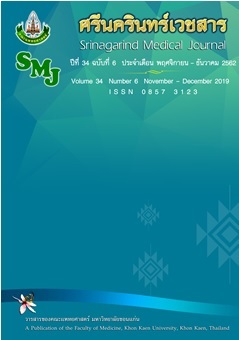Anti-Hemorrhoidal Activity of Pluchea indica Leaves Aqueous Extract in Croton Oil-Induced Hemorrhoids in Experimental Animals
Keywords:
Pluchea indica, whole gut transit time, intestinal transit rate, hemorrhoids, experimental animals, ขลู่, เวลาในการขนส่งทั้งหมดของลำไส้, อัตราการขนส่งในลำไส้, ริดสีดวงทวาร, สัตว์ทดลองAbstract
ฤทธิ์ต้านริดสีดวงทวารของสารสกัดด้วยน้ำจากใบขลู่ (Pluchea indica leaves) ในสัตว์ทดลองที่ทำให้เกิดริดสีดวงทวารด้วยน้ำมันสลอด
Koneouma Senvorasinh, คัชรินทร์ ภูนิคม, จินตนา สัตยาศัย*
ภาควิชาเภสัชวิทยา คณะแพทยศาสตร์ มหาวิทยาลัยขอนแก่น
หลักการและวัตถุประสงค์: Pluchea indica (L.) Less มีชื่อไทยว่า “ขลู่” เป็นพืชที่มีการใช้แบบดั้งเดิมเป็นยาพื้นบ้านสำหรับรักษาโรคหลายชนิด และยังนิยมนำมาดื่มเป็นชาเพื่อรักษาอาการริดสีดวงทวารโดยยังไม่มีข้อมูลทางวิทยาศาสตร์รองรับ การศึกษานี้จึงเน้นศึกษาถึงผลของสารสกัดด้วยน้ำจากใบขลู่ (PIE) ต่อการเคลื่อนไหวของทางเดินอาหารในหนูเม้าส์ และการเกิดริดสีดวงทวารที่กระตุ้นด้วยน้ำมันสลอดในหนูแรท
วิธีการศึกษา: การศึกษาครั้งนี้ใช้ charcoal test ในการศึกษาเวลาในการขนส่งทั้งหมดของลำไส้ และอัตราการขนส่งในลำไส้ เพื่อทดสอบผลของ PIE ในขนาด 50, 100 หรือ 150 มิลลิกรัม/กิโลกรัม ต่อการเคลื่อนไหวของทางเดินอาหารในหนู ICR เม้าส์เพศผู้ ส่วนการทดสอบผลของ PIE ต่อริดสีดวงทวารในหนูแรท Wistar เพศผู้ ทำโดยการป้อน PIE ในขนาด 50 มิลลิกรัม/กิโลกรัม/วัน แก่หนูติดต่อกันเป็นเวลา 10 วัน ในวันที่ 5 ของการทดลองกระตุ้นให้หนูเกิดริดสีดวงทวารโดยการสอดก้านสำลีที่ชุบสารผสมน้ำมันสลอดปริมาณ 100 ไมโครลิตร เข้าสู่ทวารหนัก ในวันที่ 11 ของการทดลองทำการการุณยฆาต แยกทวารหนัก และม้ามเพื่อชั่งน้ำหนัก และตรวจสอบความเสียหายของลำไส้ตรง
ผลการศึกษา: ผลการศึกษาพบว่า PIE ในขนาด 50, 100 หรือ 150 มิลลิกรัม/กิโลกรัม ไม่มีผลเปลี่ยนแปลงการเคลื่อนไหวของทางเดินอาหารในหนู ICR เม้าส์ ส่วนการทดลองในหนูแรทที่ทำให้เป็นริดสีดวงทวารพบว่า PIE ในขนาด 50 มิลลิกรัม/กิโลกรัม/วัน สามารถลดความรุนแรงของริดสีดวงทวารได้อย่างมีนัยสำคัญโดยลดน้ำหนักของม้าม และลำไส้ตรง และลดความเสียหายที่เกิดต่อลำไส้ตรงได้อย่างชัดเจน
สรุป: ผลการศึกษาครั้งนี้ช่วยสนับสนุนประสิทธิผลของการใช้ขลู่เป็นยาพื้นบ้านสำหรับรักษาโรคริดสีดวงทวาร อย่างไรก็ตามในขนาดที่ทำการศึกษาในครั้งนี้ไม่พบผลต่อการเคลื่อนไหวของทางเดินอาหาร
Background and Objective: Pluchea indica (L.) Less (“Khlu” in Thai) is traditionally used as a folk medicine for the treatment of many diseases and Pluchea indica leaves tea is quite famous and used to help cure hemorrhoids without any scientific evidences. This study focuses on the investigation of the effects of aqueous extract of Pluchea indica leaves on the movement of gastrointestinal tract in mice and the croton oil-induced hemorrhoid in rats.
Methods: The effects of Pluchea indica leaves aqueous extract (PIE) at the doses of 50, 100 or 150 mg/kg on whole gut transit time and intestinal transit rate in male ICR mice were tested using the charcoal test. Male Wistar rats were forced fed with PIE at 50 mg/kg/day once daily for 10 consecutive days. On day 5, the animals were induced to be hemorrhoids by inserted cotton bud swab soaked with cotton oil preparation (100 μl) into the anus. Rats were killed on day 11, anus and spleens are removed and weighed and macroscopic changes of the rectum were observed.
Results: Oral administration of PIE at either 50, 100 or 150 mg/kg had no effect on whole gut transit time or intestinal transit rate in mice. PIE at 50 mg/kg/day could significantly attenuate the severity of the croton oil-induced hemorrhoids in rats as seen by a significant reduction of spleen and rectum weights and the severity of the rectal damage was significantly reduced.
Conclusions: The result of this study supported the effectiveness of the traditional use of Pluchea indica leaves tea in the treatment of hemorrhoids. However, at the doses tested, no effect on the gastrointestinal movement was seen.
References
Margetis N. Pathophysiology of internal hemorrhoids. Ann Gastroentero 2019; 32: 1-9.
Odukoya OA, Sofidiya MO, Ilori OO, GbededoMO, Ajadotuigwe JO, Olaleye OO. Hemorrhoid Therapy with Medicinal Plants: Astringency and Inhibition of Lipid Peroxidation as Key Factors. Int J Biol Chemi 2009; 3: 111-8.
Chauhan R, Ruby K, Dwivedi J. Antioxidant, lipid peroxidation and astringency study of hydroethanolic root extracts of Bergenia ligulata, Bergenia ciliata and Bergenia stracheyi. Eur J Medicinal Plants 2016; 15: 1-10.
Suriyaphan O. Nutrition, Health Benefits and Applications of Pluchea indica (L.) Less Leaves. Mahidol University Journal of Pharmaceutical Sciences 2014; 41: 1-10.
Andarwulan N, Batari R, Sandrasari DA, Bolling B, Wijaya H. Flavonoid content and antioxidant activity of vegetables from Indonesia. Food Chem 2010; 121: 1231-5.
Yuliani Y, Soemarno, Yanuwiadi B, Leksono A. Total phenolic and flavonoid contents of Pluchea indica Less leaves extracts from some altitude habitats. Int J ChemTech Res 2015; 8: 1618-25.
Buapool D, Mongkol N, Chantimal J, Roytrakul S, Srisook E, Srisook K. Molecular mechanism of anti-inflammatory activity of Pluchea indica leaves in macrophages RAW 264.7 and its action in animal models of inflammation. J Ethnopharmacol 2013; 146: 495-504.
Sirichaiwetchakoon K, Lowe GM, Thumanu K, Eumkeb K. The Effect of Pluchea indica (L.) Less. Tea on Adipogenesis in 3T3-L1 Adipocytes and Lipase Activity. Evid Based Complement Alternat Med 2018 ; 2018: 4108787. doi: 10.1155/2018/4108787. eCollection 2018.
Abramowitz L, Godeberge P, Staumont G, Soudan D. Clinical practice guidelines for the treatment of hemorrhoid disease. Gastroenterol Clin Biol 2001; 25: 674-702.
Gupta PJ. The efficacy of Euphorbia prostrata in early grades of symptomatic hemorrhoids –a pilot study. Eur Rev Med Pharmacol Sci 2011; 15: 199-203.


